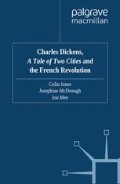Abstract
A Tale of Two Cities is acutely concerned with lost and changing social identities before, during and after the French Revolution of 1789. Ruptures and realignments of identity in he novel are expressed largely through ruptures and realignments of proper names pronounced, renounced, denounced, hidden, discovered, recorded, altered and blotted out; faces presented, represented, (mis)recognized, recorded, altered, masked, frozen, distorted, changed and severed from bodies. The novel’s preoccupation with how names and faces construct, deconstruct and reconstruct social identity is, I suggest, informed by the rise of mass picture identification between 1789 and 1859. In this period, an increasing proportion of the population gained access to established cultural forms of picture identification, like portraiture and passports. New technologies, particularly photography, also made picture identification widely available. In probing the centrality of proper names and faces to social identity and social identification, the novel also probes the identity theft that names and faces made possible. Read in the context of modern modes and means of identification, the novel raises unsettling questions about the ethics of identification and ‘face value’.
Access this chapter
Tax calculation will be finalised at checkout
Purchases are for personal use only
Preview
Unable to display preview. Download preview PDF.
Notes
While picture IDs can contain written information other than names and biomet-ric indices other than faces, these are variable and secondary. Only proper names and faces are universal and primary. Recent political discussions of identity cards in England maintain that, while fingerprint and iris recognition technologies are more accurate than even digital facial recognition technologies, not everyone has fingerprints or irises: only the face is universal. Houses of Commons Home Affairs Committee, Identity Cards: Fourth Report of Session 2003–4 (Stationery Office, 30 July 2004), vol. 1, p. 45.
Martin Lloyd, The Passport: The History of Man’s Most Travelled Document (Stroud: Sutton Publishing, 2003), p. 130.
See, for example, Michel Foucault, Madness and Civilisation: A History of Insanity in the Age of Reason, trans. Richard Howard (New York: Pantheon, 1965);
and Michel Foucault, Discipline and Punish: The Birth of the Prison, trans. Alan Sheridan (New York: Pantheon, 1978).
Jacques Derrida, Of Grammatology, trans. Gayatri Chakravorty Spivak (Baltimore, MD: Johns Hopkins University Press, 1976);
and Jacques Derrida, On the Name, ed. Thomas Dutoit, trans. David Wood, John P. Leavey, Jr and Ian McLeod (Stanford, CA: Stanford University Press, 1995).
Gilles Deleuze and Félix Guattari, A Thousand Plateaus: Capitalism and Schizophrenia, trans. Brian Massumi (London: Athlone Press, 1988), pp. 187, 194 and passim.
See, for example, H. G. Wallbott’s discussion of Lev Kuleshov’s 1919 experiments with facial expression in film montage. ‘Influences of facial expression and context information on emotion attributions’, British Journal of Social Psychology 27 (1988), 357–69.
Adrien Sée, Le Passeport en France (Chartres: Faculté de Droit, 1907), cited in Lloyd, Passport, p. 61; translation Lloyd’s.
John Torpey, The Invention of the Passport: Surveillance, Citizenship and the State (Cambridge: Cambridge University Press, 2000), pp. 17–32.
Jeremy Bentham, ‘Principles of Penal Law’ (1830), The Works of Jeremy Bentham, ed. John Bowring, 11 vols. (Edinburgh: W. Tait, 1843), vol. 1, p. 557. Iam indebted to Jane Caplan for this reference (see note 36 below).
John Stuart Mill, ‘Of Names and Propositions’, A System of Logic Ratiocinative and Inductive, Being a Connected View of the Principles of Evidence and the Methods of Scientific Investigation, 2 vols., 10th edn (London: Longmans, Green, & Co., 1879), I.
Christian Metz, The Imaginary Signifier: Psychoanalysis and the Cinema, trans. Celia Britton (Bloomington, IN: Indiana University Press, 1982), p. 176;
John M. Kennedy, ‘What Makes a Metaphor Stronger than a Simile?’ Metaphor and Symbol 14.1 (1999), 63–9.
Roman Jakobson, Selected Writings (The Hague: Mouton, 1966–81).
Jacques Lacan, Écrits: A Selection, trans. Alan Sheridan (London: Tavistock, 1977).
Verena Haser, Metaphor, Metonymy, and Experientialist Philosophy: Challenging Cognitive Semantics (Berlin: Mouton de Gruyter, 2005); Metaphor and Metonymy at the Crossroads: A Cognitive Perspective, ed. Antonio Barcelona (New York: Mouton de Gruyer, 2000).
Susan Nalbantian, The Symbol of the Soul from Holderlin to Yeats: A Study in Metonymy (London: Macmillan, 1977).
Paul de Man, Allegories of Reading: Figural Language in Rousseau, Nietzsche, Rilke, and Proust (New Haven, CT: Yale University Press, 1979).
Hayden White, Metahistory: The Historical Imagination in Nineteenth-Century Europe (Baltimore, MD: Johns Hopkins University Press, 1973).
Zoltán Kövecses, Metaphor in Culture: Universality and Variation (Cambridge: Cambridge University Press, 2005).
Jane Caplan, ‘“This or That Particular Person”: Protocols of Identification in Nineteenth-Century Europe’, in Documenting Individual Identity: The Development of State Practices in the Modern World, ed. Jane Caplan and John Torpey (Princeton, NJ: Princeton University Press, 2001), p. 51; original emphasis.
Caplan cites and builds on arguments by Beatrice Fraenkel, La signature: genèse d’un signe (Paris: Gallimard, 1992), p. 197.
Mark M. Hennelly, Jr., ‘“Like or No Like”: Figuring the Scapegoat in A Tale of Two Cities’, DSA 30 (2001), p. 220; original emphasis.
Editor information
Copyright information
© 2009 Kamilla Elliott
About this chapter
Cite this chapter
Elliott, K. (2009). Face Value in A Tale of Two Cities. In: Jones, C., McDonagh, J., Mee, J. (eds) Charles Dickens, A Tale of Two Cities and the French Revolution. Palgrave Studies in Nineteenth-Century Writing and Culture. Palgrave Macmillan, London. https://doi.org/10.1057/9780230273894_6
Download citation
DOI: https://doi.org/10.1057/9780230273894_6
Publisher Name: Palgrave Macmillan, London
Print ISBN: 978-1-349-35946-2
Online ISBN: 978-0-230-27389-4
eBook Packages: Palgrave Literature & Performing Arts CollectionLiterature, Cultural and Media Studies (R0)

